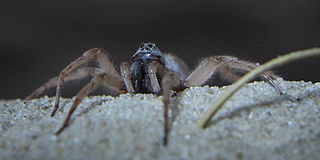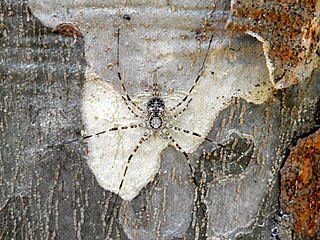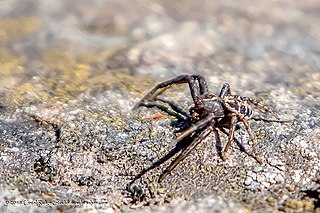
Wolf spiders are members of the family Lycosidae. They are robust and agile hunters with excellent eyesight. They live mostly in solitude, hunt alone, and usually do not spin webs. Some are opportunistic hunters, pouncing upon prey as they find it or chasing it over short distances; others wait for passing prey in or near the mouth of a burrow.

Huntsman spiders, members of the family Sparassidae, are known by this name because of their speed and mode of hunting. They are also called giant crab spiders because of their size and appearance. Larger species sometimes are referred to as wood spiders, because of their preference for woody places. In southern Africa the genus Palystes are known as rain spiders or lizard-eating spiders. Commonly, they are confused with baboon spiders from the Mygalomorphae infraorder, which are not closely related.

The Pholcidae are a family of araneomorph spiders. The family contains more than 1,800 individual species of pholcids, including those commonly known as cellar spider, daddy long-legs spider, carpenter spider, daddy long-legger, vibrating spider, gyrating spider, long daddy, and skull spider. The family, first described by Carl Ludwig Koch in 1850, is divided into 94 genera.

Crevice weaver spiders (Filistatidae) comprise cribellate spiders with features that have been regarded as "primitive" for araneomorph spiders. They are weavers of funnel or tube webs. The family contains 18 genera and more than 120 described species worldwide.

Velvet spiders are a small group of spiders almost entirely limited to the Old World, with the exception of one species known from Brazil. In Europe, some are commonly called the ladybird spiders.

Spider cannibalism is the act of a spider consuming all or part of another individual of the same species as food. It is most commonly seen as an example of female sexual cannibalism where a female spider kills and eats a male before, during, or after copulation. Cases of non-sexual cannibalism or male cannibalism of females both occur but are notably rare.

The Kauaʻi cave wolf spider, also known to local residents as the blind spider, is only known to occur in a few caves in a lava flow with an area of 10.5 km2 (4.1 sq mi) in the Kōloa–Poʻipū region of Kauaʻi, Hawaiian Islands, and only six populations are known to exist. While their nearest surface-dwelling relatives have large eyes, this species has completely lost its eyes. They reach a body length around 20 mm (0.8 in), and are reddish brown and completely harmless to people. Unlike most wolf spiders, it produces only 15 to 30 eggs per clutch. The female carries the egg sac in her mouthparts until the spiderlings hatch.

Sexual cannibalism is when an animal, usually the female, cannibalizes its mate prior to, during, or after copulation. It is a trait observed in many arachnid orders and several insect and crustacean clades. Several hypotheses to explain this seemingly paradoxical behavior have been proposed. The adaptive foraging hypothesis, aggressive spillover hypothesis and mistaken identity hypothesis are among the proposed hypotheses to explain how sexual cannibalism evolved. This behavior is believed to have evolved as a manifestation of sexual conflict, occurring when the reproductive interests of males and females differ. In many species that exhibit sexual cannibalism, the female consumes the male upon detection. Females of cannibalistic species are generally hostile and unwilling to mate; thus many males of these species have developed adaptive behaviors to counteract female aggression.

Allocosa brasiliensis is a burrowing wolf spider species from southern South America. Long known to science, it remained almost unstudied until its unusual sexual behavior was described in the early 21st century.
Eupithecia sublata is a moth in the family Geometridae first described by András Mátyás Vojnits in 1994. It is found in Tanzania.
Allocosa dufouri is a wolf spider found in Portugal and Spain.

Alireza Zamani is an Iranian arachnologist and taxonomist.
Allocosa caboverdensis is a species of wolf spider of the family Lycosidae, endemic to Cape Verde. The species was first described by Günter E. W. Schmidt and Rolf Harald Krause in 1995. Its species name refers to Cape Verde, where it is found.

Emblyna sublata is a species of mesh web weaver in the spider family Dictynidae. It is found in the United States.

Neotama mexicana, also known as the long-spinneret spider or Mexican two-tailed spider, is a species of tree trunk spider in the family Hersiliidae. It is found in a range from the United States to Peru and Guyana.

Xysticus emertoni, or Emerton's crab spider, is a species of crab spider in the family Thomisidae. It is found in the United States, Canada, Slovakia, Russia, and a range from Central Asia to China.
Habronattus tranquillus is a species of jumping spider in the family Salticidae. It is found in the United States and Mexico.
Diplocentria bidentata is a species of dwarf spider in the family Linyphiidae. It is found in North America, Europe, a range from Russia, and China.

Pholcus manueli, known generally as the cellar spider or daddy longlegs, is a species of cellar spider in the family Pholcidae. It is found in Russia, Turkmenistan, China, Korea, Japan, and the United States.

Allocosa subparva is a species of wolf spider in the family Lycosidae. They are found throughout western North America, as far north as Oregon to Idaho and as far south as Nayarit, Mexico.














